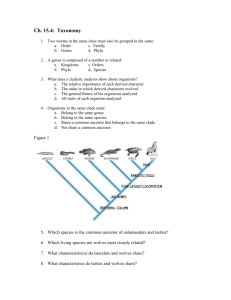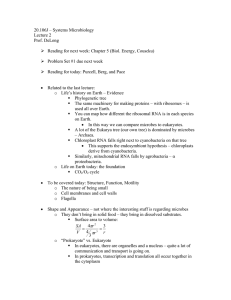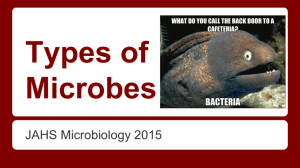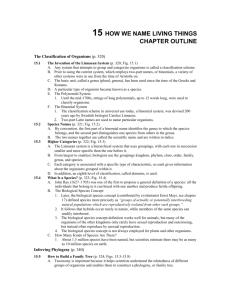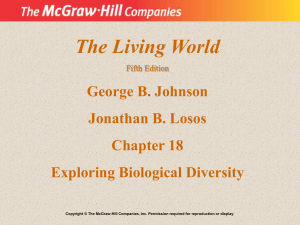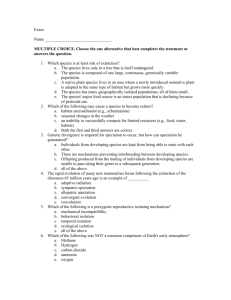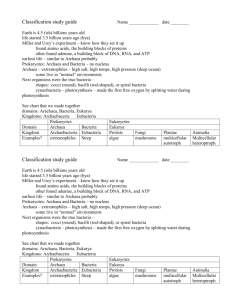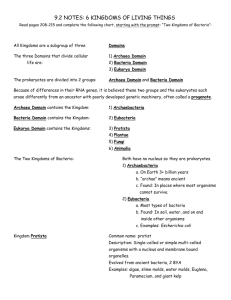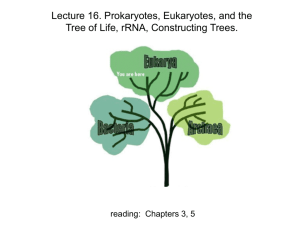presentation on Biodiversity
advertisement
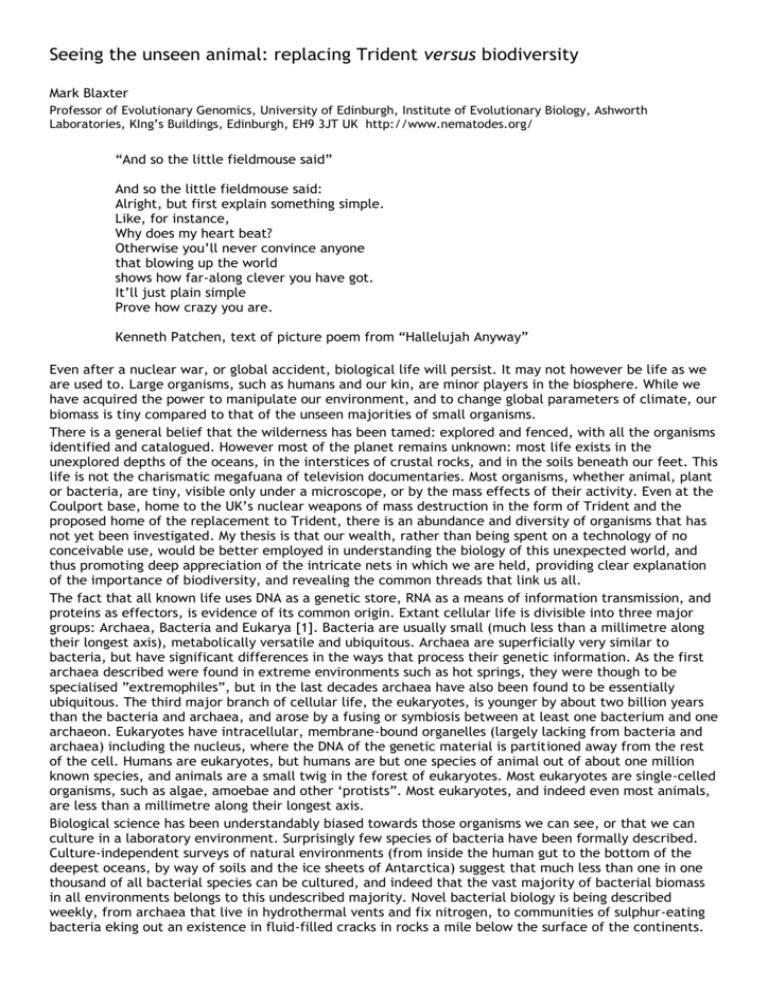
Seeing the unseen animal: replacing Trident versus biodiversity Mark Blaxter Professor of Evolutionary Genomics, University of Edinburgh, Institute of Evolutionary Biology, Ashworth Laboratories, KIng’s Buildings, Edinburgh, EH9 3JT UK http://www.nematodes.org/ “And so the little fieldmouse said” And so the little fieldmouse said: Alright, but first explain something simple. Like, for instance, Why does my heart beat? Otherwise you’ll never convince anyone that blowing up the world shows how far-along clever you have got. It’ll just plain simple Prove how crazy you are. Kenneth Patchen, text of picture poem from “Hallelujah Anyway” Even after a nuclear war, or global accident, biological life will persist. It may not however be life as we are used to. Large organisms, such as humans and our kin, are minor players in the biosphere. While we have acquired the power to manipulate our environment, and to change global parameters of climate, our biomass is tiny compared to that of the unseen majorities of small organisms. There is a general belief that the wilderness has been tamed: explored and fenced, with all the organisms identified and catalogued. However most of the planet remains unknown: most life exists in the unexplored depths of the oceans, in the interstices of crustal rocks, and in the soils beneath our feet. This life is not the charismatic megafuana of television documentaries. Most organisms, whether animal, plant or bacteria, are tiny, visible only under a microscope, or by the mass effects of their activity. Even at the Coulport base, home to the UK’s nuclear weapons of mass destruction in the form of Trident and the proposed home of the replacement to Trident, there is an abundance and diversity of organisms that has not yet been investigated. My thesis is that our wealth, rather than being spent on a technology of no conceivable use, would be better employed in understanding the biology of this unexpected world, and thus promoting deep appreciation of the intricate nets in which we are held, providing clear explanation of the importance of biodiversity, and revealing the common threads that link us all. The fact that all known life uses DNA as a genetic store, RNA as a means of information transmission, and proteins as effectors, is evidence of its common origin. Extant cellular life is divisible into three major groups: Archaea, Bacteria and Eukarya [1]. Bacteria are usually small (much less than a millimetre along their longest axis), metabolically versatile and ubiquitous. Archaea are superficially very similar to bacteria, but have significant differences in the ways that process their genetic information. As the first archaea described were found in extreme environments such as hot springs, they were though to be specialised ”extremophiles”, but in the last decades archaea have also been found to be essentially ubiquitous. The third major branch of cellular life, the eukaryotes, is younger by about two billion years than the bacteria and archaea, and arose by a fusing or symbiosis between at least one bacterium and one archaeon. Eukaryotes have intracellular, membrane-bound organelles (largely lacking from bacteria and archaea) including the nucleus, where the DNA of the genetic material is partitioned away from the rest of the cell. Humans are eukaryotes, but humans are but one species of animal out of about one million known species, and animals are a small twig in the forest of eukaryotes. Most eukaryotes are single-celled organisms, such as algae, amoebae and other ‘protists”. Most eukaryotes, and indeed even most animals, are less than a millimetre along their longest axis. Biological science has been understandably biased towards those organisms we can see, or that we can culture in a laboratory environment. Surprisingly few species of bacteria have been formally described. Culture-independent surveys of natural environments (from inside the human gut to the bottom of the deepest oceans, by way of soils and the ice sheets of Antarctica) suggest that much less than one in one thousand of all bacterial species can be cultured, and indeed that the vast majority of bacterial biomass in all environments belongs to this undescribed majority. Novel bacterial biology is being described weekly, from archaea that live in hydrothermal vents and fix nitrogen, to communities of sulphur-eating bacteria eking out an existence in fluid-filled cracks in rocks a mile below the surface of the continents. A similar story is emerging concerning single-celled eukaryotes, the protists and algae. Surveys of the open ocean, of mine waste streams and of soils are revealing a large and unexpected diversity of types of eukaryote [2]. These surveys have been carried out using a simple but revolutionary survey technique. One of the common legacies that all cellular life shares is a complex molecular machine called the ribosome. The ribosome performs similar jobs in bacteria, archaea and eukaryotes, taking the genetic information copied from the genome as RNA and translating it into proteins. The ribosome is made up of about seventy proteins and three RNA molecules. These RNA molecules have a structural role, and act as a sort of ‘active scaffold’ on which the other components assemble. These ribosomal RNAs were present in the last common ancestor of all cellular life. While the ribosomal RNAs have been evolving, as all biological systems do, natural selection has acted to maintain some sections of the RNAs (those essential for their core functions of protein synthesis) identical between all three divisions of life, and thus also between all eukaryotes. These conserved sections can be used as tags to fish out, specifically, the ribosomal RNA genes from the complex mix of all the genes from all the organisms present in an environment. By determining the sequence of these ribosomal RNA genes it is possible to obtain, for each organism, an identifying tag that includes both very specific (“What species or species group is this organism a part of?”) and more general (“Is this organism a green alga or a brown alga?”) information. These DNA sequences have been called ‘barcodes’, in analogy to the digital barcodes used for product identification [3-5]. They are a rapid, powerful and sensitive way of polling the natural world to ask ‘what is there?’. When we have applied these DNA barcoding techniques to apparently boring environments, such as the soils of a standard Scottish hill farm [3-5], we have been astounded by the numbers of different organisms we find. In the soil of a field 25 metres by 20, there can be tens of billions of individual animals, most less than 1 mm in longest dimension, deriving from hundreds of species. Most of these have not previously been described. Soils and ocean sediments are difficult to explore, for different reasons, and thus far only a few square metres of each have been examined in any detail. This is an unexplored frontier: there are likely to be tens of millions of species in these environments, performing essential ecosystem services, about which we know little or nothing. Here is a huge task: what exists in the biosphere, what functions does each component provide to the whole, and how is the emergent behaviour of the ecosystem determined? While science and technology, harnessed by political will, can devise astounding results, it perhaps behoves us to consider what frontiers we are exploring. We know that nuclear weapons can destroy human and other life, we know that we have already generated problems of decommissioning and waste that will task us for generations, and we know that nuclear weapons manifestly do not keep any peace. In parallel we also know that many social and political problems exist that may be assuaged or made tractable by investment of human and fiscal resources such as are proposed to be dedicated to the replacement of the UK’s weapons of mass destruction. As a scientist I also see that harnessing these energies, and a proportionally miniscule resource, would yield much greater understanding of the natural world and would productively inform a common task of ensuring our survival. I do not think we may ever answer Kenneth Patchen’s question ‘Why does my heart beat?’ to his satisfaction, but knowledge is not only power, it is also a step to understanding, to compassion and right action. “I hope there’s an animal somewhere that no one has ever seen And I hope nobody ever sees it.” Wendell Berry, “To the unseen animal” 1. 2. 3. 4. 5. Pace, N.R., A molecular view of microbial diversity and the biosphere. Science, 1997. 276(5313): p. 734-40. Amaral Zettler, L.A., et al., Microbiology: eukaryotic diversity in Spain's River of Fire. Nature, 2002. 417(6885): p. 137. Blaxter, M., et al., Defining operational taxonomic units using DNA barcode data. Philos Trans R Soc Lond B Biol Sci, 2005. 360(1462): p. 1935-43. Blaxter, M.L., The promise of a DNA taxonomy. Philos Trans R Soc Lond B Biol Sci, 2004. 359(1444): p. 66979. Floyd, R., et al., Molecular barcodes for soil nematode identification. Mol Ecol, 2002. 11(4): p. 839-50. Coulport, 07 January 2007
